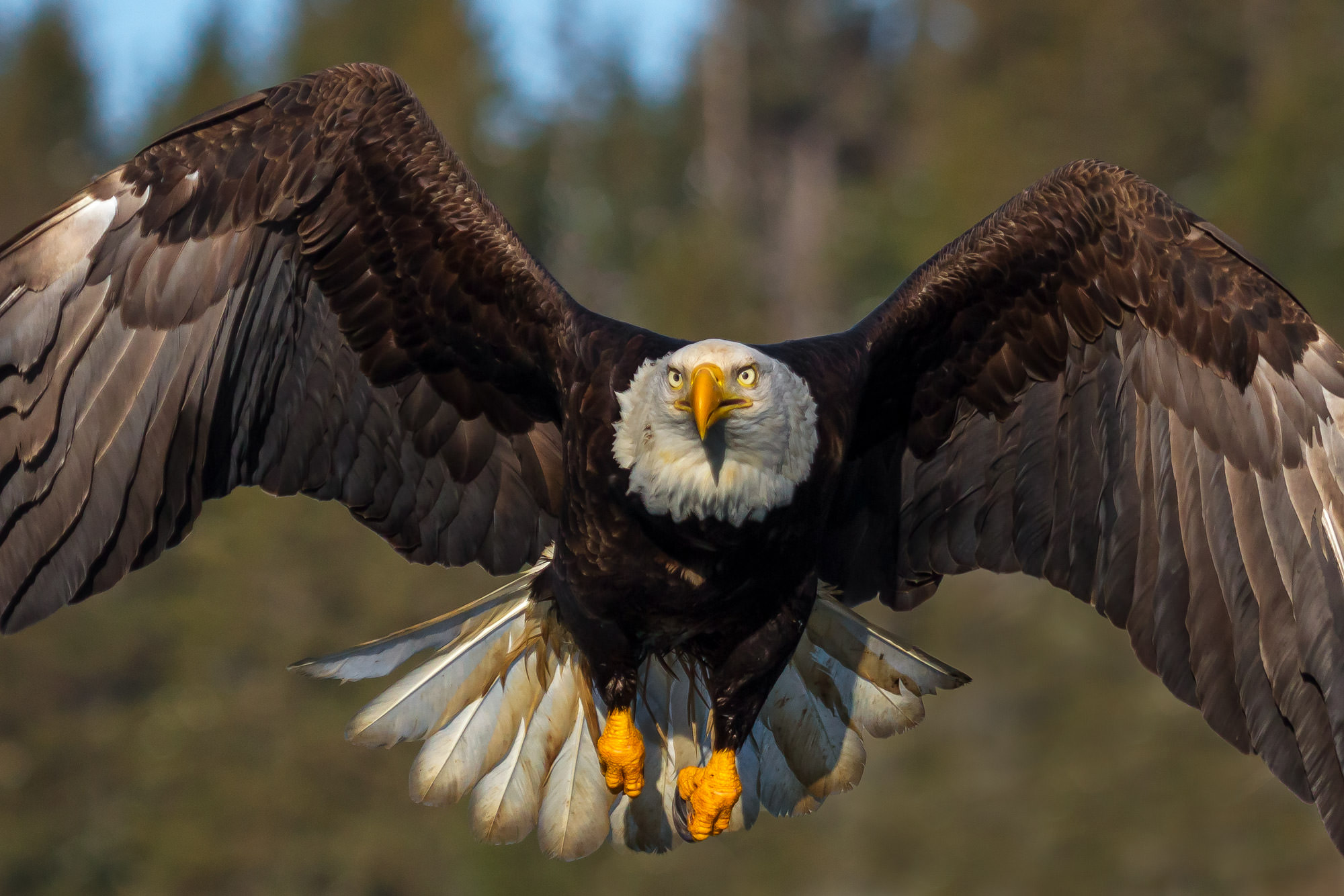zoomacademia.com – Eagles are celebrated worldwide as symbols of power, freedom, and grace. Found on nearly every continent, these impressive birds are known for their powerful flight, sharp eyesight, and exceptional hunting skills. Let’s explore the characteristics, habitats, unique species, and cultural significance of eagles across the globe.
1. Physical Traits: What Makes Eagles So Majestic?
Eagles are among the largest birds of prey, known for their muscular build, broad wings, and sharp features that help them survive and thrive.
- Size and Strength
Different eagle species vary in size, but all share impressive physical power. Some eagles, like the Harpy Eagle and Steller’s Sea Eagle, weigh over 20 pounds and boast wingspans over 7 feet. Their powerful wings let them soar at great heights, conserving energy as they glide for long distances. - Sharp Vision
Eagles are renowned for their keen eyesight, about four times sharper than that of humans. They can spot prey from two miles away, allowing them to hunt with remarkable accuracy. Their forward-facing eyes give them excellent depth perception, crucial for tracking and capturing prey. - Talons and Beak
Eagles have strong, curved talons for gripping and holding onto prey and hooked beaks designed to tear flesh. Together, these features make eagles formidable hunters of fish, birds, small mammals, and even reptiles.
2. Habitat and Global Presence of Eagles
Eagles are highly adaptable and thrive in diverse habitats around the world, from mountain ranges to dense forests and coastal areas.
- Variety of Habitats
Different eagle species choose specific habitats based on their diet and nesting preferences. For example, Bald Eagles are often found near rivers, lakes, and coastlines, where they can easily hunt fish. Harpy Eagles, in contrast, inhabit the rainforests of Central and South America, where they hunt tree-dwelling mammals. - Where Eagles Live
There are around 60 eagle species worldwide, with most found in Eurasia and Africa. Notable species include the Bald Eagle in North America, the White-bellied Sea Eagle in Australia, and the African Fish Eagle, known for its powerful hunting skills and distinct call.
3. Unique Eagle Species Around the World
Each eagle species has its own adaptations and characteristics, suited to its specific environment.
- Bald Eagle
A symbol of the United States, the Bald Eagle has a distinctive white head and tail against its dark brown body. These eagles mate for life and are highly protective of their nesting territories, often found near large bodies of water where they hunt fish. - Golden Eagle
Known for its golden-brown feathers, the Golden Eagle is among the fastest raptors, reaching diving speeds of up to 200 miles per hour. This species is native to North America, Eurasia, and parts of North Africa, where it hunts small mammals across mountains and grasslands. - Harpy Eagle
Found in tropical rainforests of Central and South America, the Harpy Eagle is one of the largest and most powerful eagles. With massive talons and a distinct feathered crest, it preys on tree-dwelling animals like monkeys and sloths. - Steller’s Sea Eagle
Native to Northeast Asia’s coastal areas, the Steller’s Sea Eagle is one of the heaviest eagle species, with a wingspan over 8 feet. Its striking white and black coloring, combined with its impressive size, makes it a remarkable sight.
4. Eagles’ Role in Nature
As apex predators, eagles help maintain the balance within their ecosystems by controlling the populations of other species.
- Ecological Balance
By preying on a range of animals, eagles prevent overpopulation of certain species, which can harm the environment. For example, Bald Eagles help control fish populations in lakes and rivers, while Golden Eagles regulate rabbit and rodent populations in grasslands. - Environmental Indicators
Eagles are sensitive to environmental changes, making them indicators of a healthy ecosystem. Their presence in a region often suggests clean water, abundant food, and a healthy environment overall. Conservation efforts to protect eagle habitats benefit entire ecosystems and other species.
5. Cultural and Symbolic Importance of Eagles
Eagles have been symbols of strength, freedom, and bravery in mythology, art, and national emblems for centuries.
- In Mythology
In Greek mythology, Zeus, the king of gods, was often depicted with an eagle as a symbol of his power over the skies. Norse mythology linked the eagle to wisdom, with an eagle perched atop Yggdrasil, the World Tree. - National Symbols
The Bald Eagle, chosen as the symbol of the United States in 1782, represents freedom, independence, and resilience. Other countries, including Germany, Poland, and Egypt, also use eagle motifs in their national emblems, reflecting strength and sovereignty. - In Native American Culture
For many Native American tribes, the eagle is a sacred creature believed to carry messages between the spiritual world and humanity. Eagle feathers are considered sacred, used in ceremonies and symbols of wisdom, protection, and courage.
6. Eagle Conservation Efforts
While some eagle species, like the Bald Eagle, have made remarkable comebacks due to conservation efforts, other species are still at risk.
- Success Stories
The Bald Eagle was once endangered but is now thriving thanks to habitat protection and restrictions on harmful pesticides. This conservation success has served as a model for other endangered species. - Ongoing Challenges
Species like the Philippine Eagle and Steller’s Sea Eagle remain endangered due to habitat loss, illegal hunting, and climate change. Conservationists work globally to protect eagle habitats, enforce regulations, and educate communities on the importance of these majestic birds.
In Summary
Eagles are magnificent creatures, celebrated for their grace, power, and iconic status in culture and nature alike. Their roles as predators help maintain ecological balance, while their symbolism inspires people around the world. Protecting these incredible birds ensures that future generations can continue to admire and learn from the beauty and resilience of eagles.







